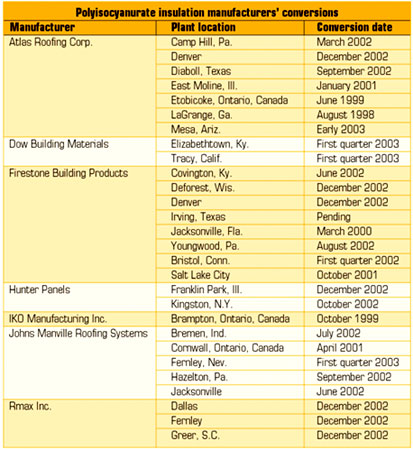Dec. 31 marks a significant milestone for polyisocyanurate insulation manufacturers—they must convert to third-generation blowing agents for their polyisocyanurate products. If you are involved in specifying, purchasing or installing rigid board polyisocyanurate roof insulation, you need to be aware of the changes.

Plant-by-plant statuses of polyisocyanurate insulation manufacturers' conversions to alternative blowing agents and third-generation polyisocyanurate insulation products
Citing concerns with the ozone-depleting potential of certain chemicals, the U.S. Environmental Protection Agency (EPA) mandated reductions in the use of a number of chemicals. Such a mandate was the primary reason for polyisocyanurate insulation manufacturers to change the blowing agent (a raw material component used when manufacturing polyisocyanurate insulation) from chlorofluorocarbon to hydrochlorofluorocarbon (HCFC-141b) during the early 1990s.
Polyisocyanurate insulation manufacturers now face an additional EPA-mandated deadline. After Dec. 31, chemical manufacturers no longer will be permitted to produce HCFC-141b. As a result, polyisocyanurate insulation manufacturers again are forced to change a critical component in the manufacturing of polyisocyanurate insulation.
Manufacturers' statuses
Although polyisocyanurate insulation manufacturers have known about the deadline for some time, development of alternative blowing agents—and the resulting third-generation products—has been relatively slow.
In October, NRCA contacted polyisocyanurate insulation manufacturers to inquire about their conversion statuses and determine the presence of third-generation polyisocyanurate insulation products in the marketplace.
When evaluating the survey results (shown in the figure), realize that the plants that will not be converted by the deadline are not necessarily violating EPA's mandate. The mandate specifically restricts the manufacture of HCFC-141b, not its use in finished products.
Closing thoughts
Be aware of the statuses of manufacturers' conversions to third-generation products. Also, realize the physical properties and performance attributes of third-generation polyisocyanurate insulation products will not necessarily be identical to second-generation polyisocyanurate insulation products.
Mark S. Graham is NRCA's associate executive director of technical services.

